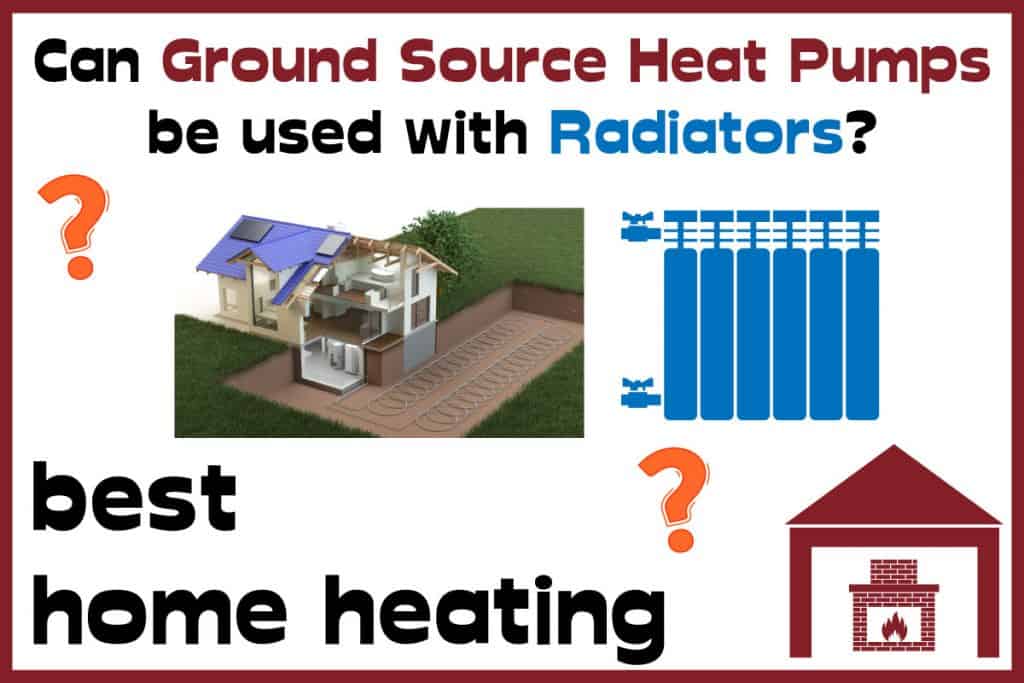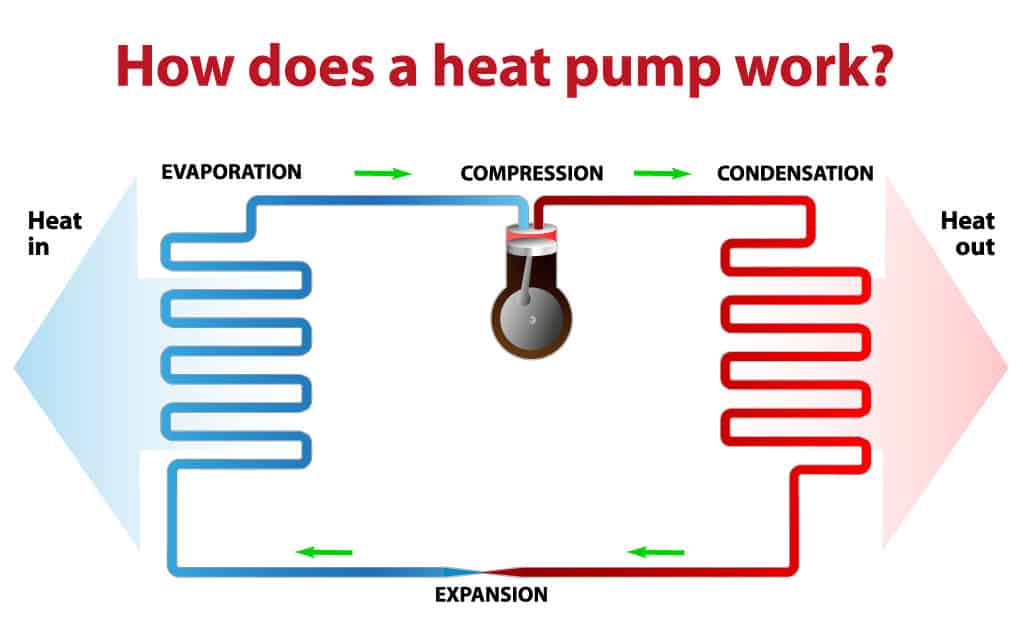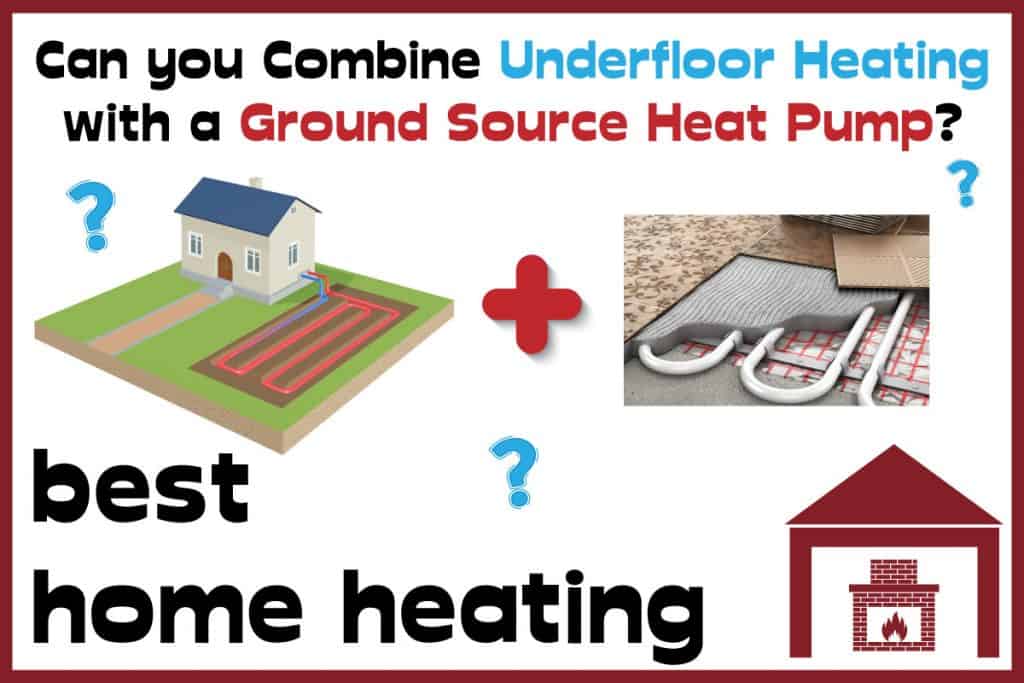Geothermal heat pumps, also known as ground source heat pumps, are one of the most promising solutions to high energy costs. This green technology has soared in popularity in recent years for many reasons. If you are wondering whether or not you can use your geothermal heat pump with radiators, read on.
Ground source heat pumps can be used with radiators. Heat flow is proportional to surface area and temperature. The radiators used with ground source heat pumps should be oversized to deliver appropriate flow temperatures.
You can use your existing radiator with a ground source heat pump. However, the heating system will not be satisfactorily efficient unless the radiator is oversized.
In this post, we are going to discuss everything you need to know about using geothermal/ground source heat pumps with radiators.

Do you use radiators with ground source heat pumps?
First, let’s see how a ground source heat pump works. How does the heat transfer from the ground to a radiator in the first place?
- A ground source heat pump takes advantage of the sun’s energy stored underground. Underground pipes, designed to allow heat transfer through their walls, are installed to access the ground’s constant temperature.
- The fluid running through the array of ground pipes is a mixture of water and antifreeze. This mixture absorbs the low-grade heat from the ground array as it circulates. Lots of heat energy can be absorbed this way due to the length and surface area of the pipes.
- On its return to the control hub, the water-antifreeze mixture enters a heat exchanger, also known as an evaporator. The heat exchanger has two sealed-off compartments, one housing the flowing water-antifreeze mixture, and another holding a volume of refrigerant. The two liquids never mix together.
- The heat energy in the water-antifreeze mixture, which has been absorbed from the ground, then diffuses through the pipes in the heat exchanger and into the refrigerant liquid, which then boils into a gas due to its very low boiling point. The water-antifreeze mixture continues to circulate back into the ground loops for another cycle.
- The gas is then fed into a compressor, which increases the pressure of the gas and hence its temperature. This hot gas then flows into a second heat exchanger, known as the condenser. This component is very similar to the evaporator heat exchanger which transferred the heat from the water-antifreeze mixture. However, this time it transfers heat from the refrigerant gas and into a flowing water circuit which can then go off to heat the home via radiators or underfloor heating, or perhaps heat the water supply to the taps.
- The refrigerant gas that has lost its heat then condenses back to a liquid as it cools beneath its boiling point. It then passes through an expansion valve, reducing the temperature and pressure and circulating back to the evaporator heat exchanger ready to meet more warmed water-antifreeze mix and to repeat the cycle.
You can learn more about how radiators combine with ground source heat pumps by watching this video from Kensa Heat Pumps on Youtube.
The heat can be fed into the radiator in your house, but that’s not mandatory. In order to work efficiently, the radiator must be correctly sized to be compatible with a lower flow temperature.
Geothermal heat pumps operate efficiently at lower flow temperatures ( 45°C – 50°C). Typically, radiators are sized for a flow temperature of 71°C – 82°C.
In this case, your existing radiator may not be correctly sized if you’re planning to combine it with a ground source heat pump. To make the radiator compatible with a ground source heat pump, you may need to replace your radiator with an oversized one. If there is a microbore pipe that attaches to the radiator, the pipe also needs to be replaced.

You can also combine a ground source heat pump with an underfloor heating system. Underfloor distribution systems have large surface areas and operate at lower flow temperatures of around 35°C. If you combine an underfloor heating system with a ground source heat pump, you can achieve an efficiency of up to 400%.
Do you need specific types of radiators for a ground source heat pump?
In general, there are four types of radiators most homeowners use. These include iron cast radiators, stainless steel radiators, steel radiators, and fan convectors.

Iron cast radiators have great conductivity and provide coverage in large spaces. However, these units are expensive. Stainless steel radiators, on the other hand, can withstand extreme temperatures and are easy to customize and clean. But like cast iron radiators, stainless steel units are pretty expensive.
Fan-assisted radiators, also known as fan convectors, works well with low-temperature systems. A fan convector comprises sophisticated elements designed to distribute heat evenly and compactly. These units are easy to install and allow users to control the direction of heat.
Fan-assisted radiators have a greater surface area, which is why they work very well with geothermal heat pumps.
While fan convectors require electricity to run, the savings in heat energy easily offset the cost of electricity. These units come with sophisticated temperature controls designed to provide you with the required amount of heat.
While you can use any radiator with a large surface area with a geothermal heat pump, a fan convector is preferable.
Would you need to buy new radiators when fitting a ground source heat pump?
In older properties, most radiators are designed for a flow temperature of 71°C – 82°C. In contrast, a geothermal heat pump has a flow temperature of 45°C – 50°C. So, the chances are that your existing heat pump will be undersized for a ground source heat pump.
In such a case, you will have to replace your existing radiators with oversized ones compatible with the low flow temperatures of your ground source heat pump.

If you have a large radiator already installed, you probably won’t have to replace it. In general, large radiators that take a while longer to warm up can be seamlessly used with geothermal heat pumps.
If you do not want to buy new radiators, increasing the outlet temperature of your heat pump can be a viable option. However, it is important to remember that as a heat pump’s outlet temperature increases, its running cost increases, reducing the overall efficiency.
Can you combine central heating systems with ground source heat pumps?
Yes, you can combine central heating systems with ground source heat pumps. In fact, an integrated heating system, also known as a hybrid heating system, allows you to get the best of both worlds. By combining the traditional and green systems, you can switch between them whenever needed. The heat pump will operate at total capacity most of the time, and the furnace will complement the system only during extreme weather conditions.
The overall efficiency of a home heating system greatly depends on the radiator. Ground source heat pumps require radiators with large surface areas to transfer heat. So, combining your central heating system with a ground source heat pump will be pretty expensive if you do not have large radiators or underfloor heating installed.
If there are two floors, consider installing underfloor heating downstairs and radiators upstairs. Keep in mind that the underfloor heating system will absorb the heat from the pump, and the heat pump will have a low return temperature.

The radiators will heat up slower than the underfloor heating. Until the underfloor heating is up and running, the radiators may feel rather lukewarm. In short, if you connect both underfloor heating and radiators to the system, the radiators are not likely to heat up rapidly.
Conclusion – Main Radiator Considerations When Planning A Ground Source Heat Pump
If you plan to use a ground source heat pump with a radiator, choose the radiator carefully. In general, ground source heat pumps require radiators with large surface areas.
Low water content radiators work well with low-temperature systems like geothermal heat pumps. They warm up rapidly, do not necessarily overheat, and cool down quickly. In fact, when compared to steel panel radiators, they are considered up to 15% more economical.
If you have steel panel radiators installed with your gas or oil boiler, you should replace them with larger ones. In some cases, to achieve the required output, you may need to get additional radiators installed.
To avoid short cycling, consider using about 25% of the radiators as bypass radiators. Place these bypass radiators in hallways and areas where close temperature control is not required. Use a buffer vessel if temperature control is needed in all zones.
When choosing a geothermal heat pump radiator, opt for a compact copper or aluminum heat exchanger. A radiator with fewer materials is easier to use and heats up more rapidly.
If you still have questions about your heating systems, it’s best to talk to a reliable ground source heat pumps provider to learn about your options. An experienced service provider can help you make informed decisions.
